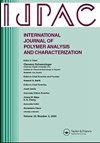Improving flame resistance and shielding properties for cross-linked polyethylene (XLPE) using nanoclay filler
IF 1.6
4区 工程技术
Q4 POLYMER SCIENCE
International Journal of Polymer Analysis and Characterization
Pub Date : 2024-10-02
DOI:10.1080/1023666X.2024.2394226
引用次数: 0
Abstract
Polymers play an essential role in both industry and medical fields due to their diverse and adaptable properties. In this work, prepared crosslinking polyethylene (XLPE) samples with hydrophilic bentonite nanoclay fillers (H2Al2O6Si) at concentrations of 0, 1, 2.5, 4, and 5 wt% enhance their flame-retardant and radiation shielding efficiency. The research investigated flame retardancy and thermal stability parameters. The XLPE/H2Al2O6Si nanocomposite polymer sheets were exposed to a collimated beam of fast neutrons using an Am/Be neutron source (5 Ci) and to gamma radiation using a 137Cs point source (5 μCi) to assess their radiation shielding properties. The study found that uniform dispersion of nanoclay particles enhanced the thermal properties of the composite, forming a char layer that acted as a barrier, slowing thermal decomposition and reducing the heat release rate. Limiting oxygen index (LOI) increased from 28% to 34%, and burning rate improved with higher nanoclay concentrations. Additionally, absorption and optical band gap calculations decreased with increasing filler concentrations. Radiation attenuation capabilities increased by approximately 40% for neutrons and 30% for gamma radiation compared to pure XLPE. The study concluded that incorporating nanoclay fillers into XLPE enhances its shielding capabilities and improves flame resistance properties, making the prepared samples suitable for various industrial applications.
使用纳米粘土填料提高交联聚乙烯(XLPE)的阻燃性和屏蔽性能
聚合物因其多样化和适应性强的特性,在工业和医疗领域都发挥着至关重要的作用。在这项工作中,制备了具有亲水性的交联聚乙烯(XLPE)样品。
本文章由计算机程序翻译,如有差异,请以英文原文为准。
求助全文
约1分钟内获得全文
求助全文
来源期刊
CiteScore
3.50
自引率
5.30%
发文量
37
审稿时长
1.6 months
期刊介绍:
The scope of the journal is to publish original contributions and reviews on studies, methodologies, instrumentation, and applications involving the analysis and characterization of polymers and polymeric-based materials, including synthetic polymers, blends, composites, fibers, coatings, supramolecular structures, polysaccharides, and biopolymers. The Journal will accept papers and review articles on the following topics and research areas involving fundamental and applied studies of polymer analysis and characterization:
Characterization and analysis of new and existing polymers and polymeric-based materials.
Design and evaluation of analytical instrumentation and physical testing equipment.
Determination of molecular weight, size, conformation, branching, cross-linking, chemical structure, and sequence distribution.
Using separation, spectroscopic, and scattering techniques.
Surface characterization of polymeric materials.
Measurement of solution and bulk properties and behavior of polymers.
Studies involving structure-property-processing relationships, and polymer aging.
Analysis of oligomeric materials.
Analysis of polymer additives and decomposition products.

 求助内容:
求助内容: 应助结果提醒方式:
应助结果提醒方式:


